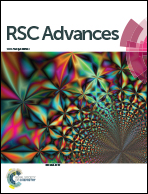Influence of CuO morphology on the enhanced catalytic degradation of methylene blue and methyl orange†
Abstract
In this work, CuO nanostructures of different morphologies were synthesized via a precursor mediated, two step hydrothermal method. The as obtained CuO nanostructures were systematically characterized by X-ray powder diffraction, Fourier transform infra-red spectroscopy, scanning electron microscopy, transmission electron microscopy, micro-Raman spectroscopy, Brunauer–Emmett–Teller N2 adsorption–desorption analysis and UV-visible spectroscopy. The results reveal that the CuO nanostructures are monoclinic, with definite morphologies, and they were employed for the catalytic degradation of cationic and anionic dyes in the presence of H2O2. The CuO nanostructures exhibit different efficiencies and rates towards the degradation reactions by the changing of the morphologies. Moreover, the effects of catalyst dosage and reaction temperature were also addressed in dye degradation reactions. The results imply that the increasing temperature led to higher reaction rates and efficacy. The kinetic data reveals that the process of degradation of the dyes was modeled by the pseudo-first-order kinetics involving adsorption and redox reaction. All the thermodynamic parameters, including activation energy (Ea), enthalpy (ΔH#), entropy (ΔS#) and free energy (ΔG#) of activation were calculated for the oxidation reaction. The generation of reactive ·OH from the homolytic cleavage of H2O2 was activated by the Cu2+ ions. The nanostructures also show good recyclability and high stability, up to the fifth cycle of the degradation reaction. Further, the degradation of dyes was confirmed by the FTIR analysis.


 Please wait while we load your content...
Please wait while we load your content...